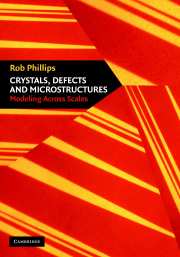Book contents
- Frontmatter
- Contents
- Preface
- Acknowledgements
- Notes on Units, Scales and Conventions
- Part One Thinking About the Material World
- Part two Energetics of Crystalline Solids
- Part three Geometric Structures in Solids: Defects and Microstructures
- Part four Facing the Multiscale Challenge of Real Material Behavior
- 11 Points, Lines and Walls: Defect Interactions and Material Response
- 12 Bridging Scales: Effective Theory Construction
- 13 Universality and Specificity in Materials
- References
- Index
11 - Points, Lines and Walls: Defect Interactions and Material Response
Published online by Cambridge University Press: 29 October 2009
- Frontmatter
- Contents
- Preface
- Acknowledgements
- Notes on Units, Scales and Conventions
- Part One Thinking About the Material World
- Part two Energetics of Crystalline Solids
- Part three Geometric Structures in Solids: Defects and Microstructures
- Part four Facing the Multiscale Challenge of Real Material Behavior
- 11 Points, Lines and Walls: Defect Interactions and Material Response
- 12 Bridging Scales: Effective Theory Construction
- 13 Universality and Specificity in Materials
- References
- Index
Summary
Defect Interactions and the Complexity of Real Material Behavior
In previous chapters, we have begun the attack on the problem of the observed thermomechanical properties of materials from a number of different perspectives. One of our key realizations has been the conspiratorial role of defects in governing the response of materials. Thus far, we have largely concentrated on the structure and energetics of individual defects with less attention given to the implications of these defects for material response. Our efforts have been primarily divided along dimensional lines, with point defects, line defects and interfacial defects each being treated as an end unto itself. The concern of the present chapter is to make evident the claim that such divisions are a theorist's artifice and that, in general terms, it is the synthetic response of all of these different types of defects in concert that gives rise to the observed complexity of materials.
We begin our discussion with the consideration of diffusion. In earlier chapters, we noted that diffusion is mediated by the presence of point defects. However, until now, we have not given any quantitative analysis of the lubricating effect of other defects in the context of diffusion. We have already seen in fig. 9.1 that bulk diffusion can be negligible in comparison with the diffusion that takes place along surfaces, grain boundaries and dislocations. As a particular realization of this class of problem, we consider the case of surface diffusion with special reference to some of the counterintuitive diffusion mechanisms that take place at surfaces.
- Type
- Chapter
- Information
- Crystals, Defects and MicrostructuresModeling Across Scales, pp. 587 - 648Publisher: Cambridge University PressPrint publication year: 2001



